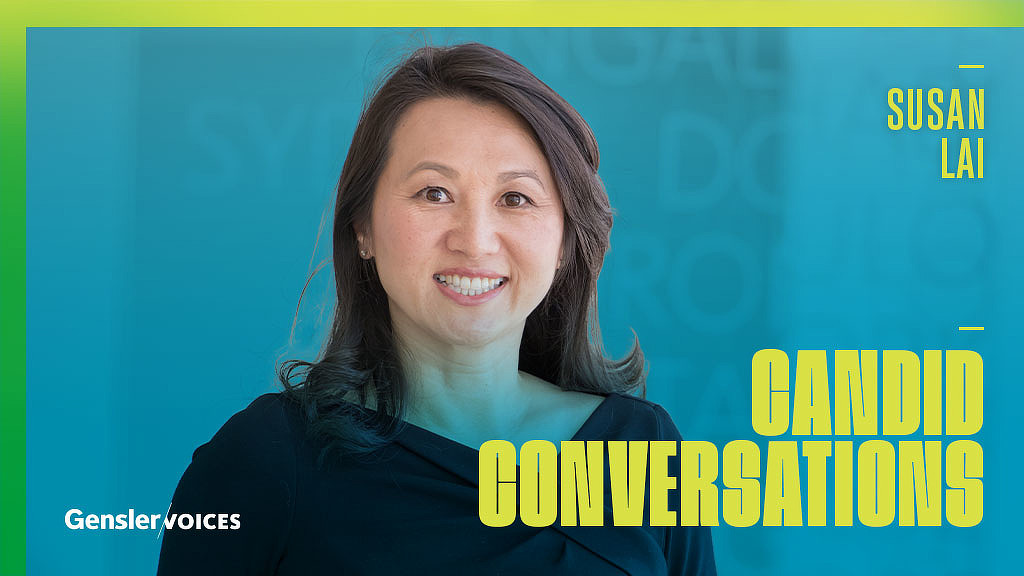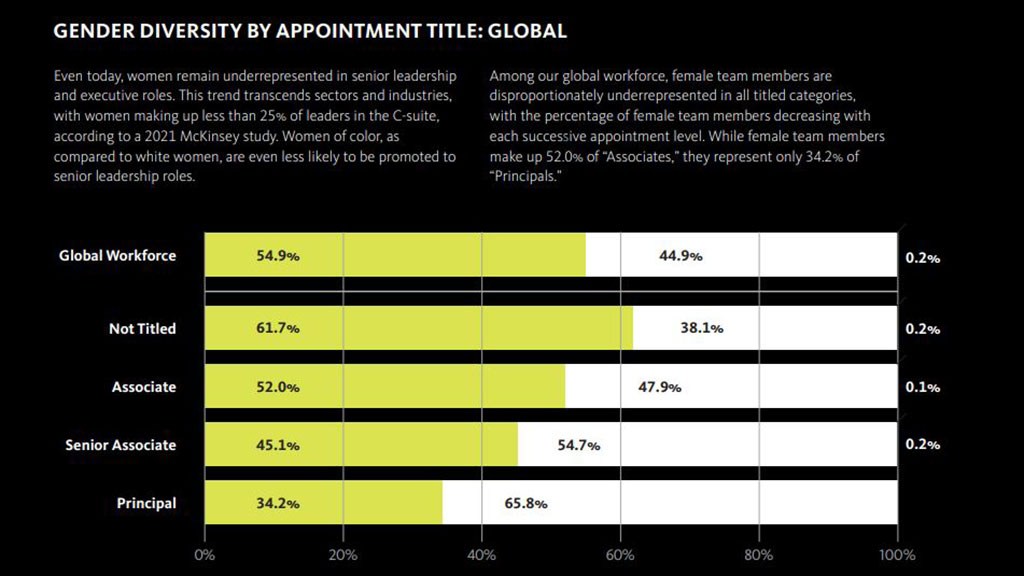Empathy, Embracing Differences, and the Power of Good Listening: A Conversation with Susan Lai
November 30, 2022
After the murder of George Floyd, Gensler established its Diversity, Equity, and Inclusion (DEI) committee, which soon developed the Five Strategies to Fight Racism. The strategies range from a commitment to increase the racial diversity within the firm to the creation of education opportunities for Black students through scholarship funding. Inspired by the new mission, Gensler’s Southwest Region launched the Race, Diversity, and Inclusion Regional Committee (RDI) to further tackle a larger suite of topics around these issues.
The RDI Committee sought to create a space for Gensler team members to openly talk about their life experiences, find encouragement and support, and hear stories from people different from themselves. They wanted to facilitate more candid conversations. In that spirit, the committee established Candid Conversations, a recurring gathering, to celebrate the diversity of Gensler’s people and their personal stories. Candid Conversations is a platform that fosters dialogue, emotional safety, and compassion for all topics related to Race, Diversity, and Inclusion.
Participants, also known as “storytellers,” share openly about their individual hardships and successes as unique individuals in the world. Through these stories, the RDI Committee hopes to increase the awareness and empathy of Gensler team members.
To learn more about the Candid Conversations, how it was developed, how it works, and the impact it’s had, we sat down with Regional Sciences Leader Susan Lai, who is one of the founding members of the initiative, for a conversation of our own.
Can you describe what led to the founding of Candid Conversations?
In 2021, when there was a rise in anti-Asian racism, hate crimes specifically, we were able to further recognize the intersectionality of racism. Asians stand in solidarity with Blacks. The first Candid Conversation took place in May 2021 with a focus on the personal stories of Asian American Pacific Islanders (AAPI). Over 90 people attended our first event. We followed up with part two of AAPI stories the following month during the end of AAPI heritage month. We discovered that the Southwest region was yearning for deeper connection in the height of COVID quarantine. The meeting was so well received by the region that it set the framework for future Candid Conversations.
How do you organize the gatherings? How does a typical gathering look?
First, we identify a set of topics. After that, we identify our speakers. A small task force from the RDI group will listen to the speakers’ practice sessions and offer responses and suggestions. Typically, the storyteller doesn’t quite know how to talk about these difficult topics. The coaching session helps refine their overall outline and gives them an opportunity to bond with the other speakers. There is a lot of testing on how the stories sound aloud, and the RDI group has been a sounding board to help tighten up the delivery.
Next, we facilitate the event, which usually occurs during our lunch hour. We present attendees with questions intended to challenge their thinking on the theme. For example, we might ask: "What is your story that defines who you are today?” or “Who are you advocating for and who is your role model?” Another might be: “What do hope you will accomplish by telling your story?” We ask these prompts so we can understand the individual’s background, what challenges they went through, who helped them, and how they want their listeners to respond.
Finally, the storytellers share their experience, and we all learn and grow together.
What kinds of topics are discussed at the gatherings?
Initially, we started with conversations about race, but we quickly realized that the stories were intersectional and could not be labeled. Topics that keep coming up include the immigrant’s story, living multiple cultures, and being multiracial. We all relate to one another and perhaps fall into many buckets. We have talked about cultural assimilation with examples such as changing your name professionally, so that someone can say it correctly.
Family related topics such as caregiving, parents rearing biracial children, non-binary children, and special needs have also been discussed. And we have talked about gender equality in the workplace, and specifically, why are female architectural design directors unicorns at Gensler? Gender identity and the use of pronouns has been the topic of our recent talks and we hope to continue the dialogue with our LGBTQIA + community. This year, we have had two sessions on human rights with discussions on how gender and race play a role in health care and in our daily lives, as compared to other countries. In the beginning of the new year, we hope to discuss inclusive design.
Why do you call the speakers “storytellers”?
As architects and designers, we tell the story of our projects all the time. For Candid Conversations, we are telling the personal story of our lives. We are not necessarily speaking on some subject matter as experts, but we are speaking from the heart. In the initial prep work leading up to the event, we spend a lot of time coming up with each storyteller’s title. One example of a title from the first talk was, “My Perspectives as a 4th Gen Asian America: Cultural Insights from an East LA Gravesite.” The storyteller explained her background, and she described an instance in her life to explain her story.
What have you learned about yourself and others through serving as a mentor to some of the speakers and a moderator at the gatherings?
It’s tough to hear about the racism and microaggressions in our community. But it is better to know about them than to be unaware that it is happening even within our organizations and in our neighborhoods.
Everyone has a story. Everyone wants to be included and have a seat at the table despite race, roles, and titles. We need to listen first to hear each other’s perspective. I also care more about being a designer who is concerned about inclusive design. Finally, this is all about the human connection and the importance of it, even in the workplace.
I imagine the sensitive (and perhaps even controversial) nature of some Candid Conversations topics can be difficult to navigate. How is this challenge managed?
To ensure that every gathering is a safe space for conversation where storytellers can speak freely, we’ve established a set of “ground rules” as a foundation to set the tone for the discussions. One of those rules is that we never record the talks. We all have those moments where we hear ourselves recorded and think, why did I say that? Or why do I sound different? But with it not being recorded, storytellers have more of a freedom to speak fluidly and not second guess themselves. It’s akin to not posting something on social media to have someone comment about it later.
It’s also important to establish that the vulnerability and transparency of the storytellers’ willingness to share their story is something we need to be respectful of and grateful for. During the gathering, we usually have only one moderator. As a moderator, I’ll be the first to admit that I make mistakes too — even in my nomenclature or my responses, or even in how I pronounce someone’s name.
Also, we keep from being controversial or political because these are people’s individual stories. It’s hard for any listener to counteract or attack someone for what they went through. To be clear, we are not talking about people’s political or religious agendas. We are sensitive to this and want to have all perspectives. In our next talk about human rights and women's equality, we want to tackle the significance of the overturning of Roe v Wade. We understand that this is sensitive, and it will be difficult to navigate. But our focus is on the individual’s stories and backgrounds, regardless of the political leaning.
Listening is a core part of Candid Conversations. What do you believe makes a good listener and why it is important?
I believe good listening is not about trying to solve something, but about learning something from another. Listening shows respect and regard for those that we work with, even if we do not have the same cultural background, political belief, or life experiences. We may have conflicts in our thinking, but active listening can help to resolve that conflict. Listening is also reciprocal. When leaders are listening to one of their team members talk, they are modeling that they are someone others will want to listen to. Ultimately, listening builds empathy and helps to build knowledge.
How do the gatherings end? With such heavy stories, it feels like it would be easy for things to get dark, or even depressing.
We keep the sessions positive by being grateful for the storytellers. We work to acknowledge their strength to share for the benefit of all of us. Sometimes the stories might start with their background and upbringing, and they might describe some tragedy or some disastrous event. But ultimately, Candid Conversations is about storytellers letting the audience know how they were able to triumph over the situation. They had a victory over some notable event in which they are able to share their successes with the audience. Then, as a conclusion, storytellers share some nugget of wisdom to pass on to the group.
What is your wish for the future of Candid Conversations?
I hope Candid Conversations takes on a life of its own. Our intention is for this to be replicated in other regions, even other companies. Within Gensler, we’d love to bring in outside speakers, whether clients or those adjacent to our industries. We are also mentoring other leaders to serve as moderators and mentors so these gatherings can happen at any time across the organization. I hope these stories can become part of our everyday communication and connection. They don’t just need to happen on Tuesdays over Zoom at lunchtime, they can be part of our everyday interactions.
For media inquiries, email .

